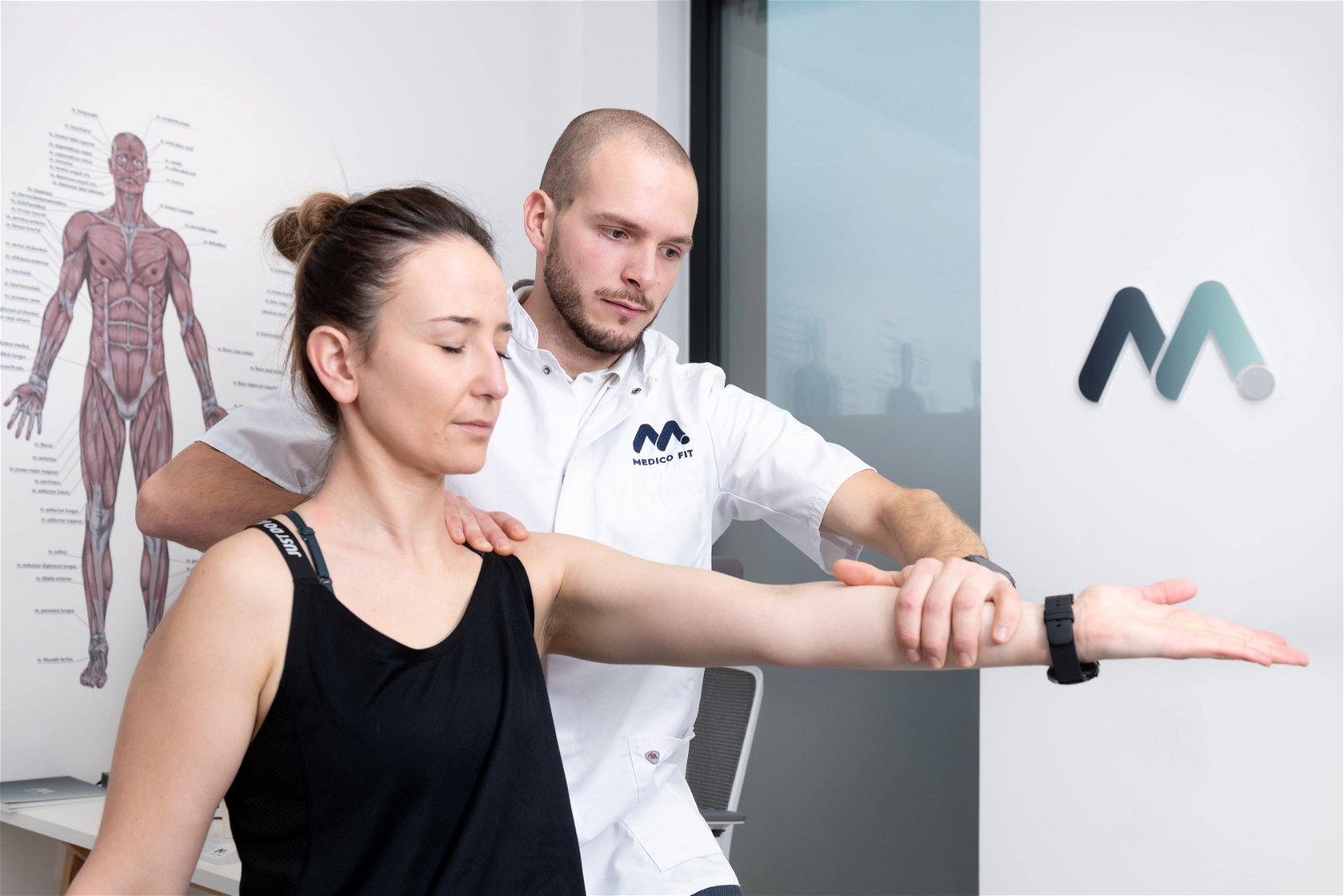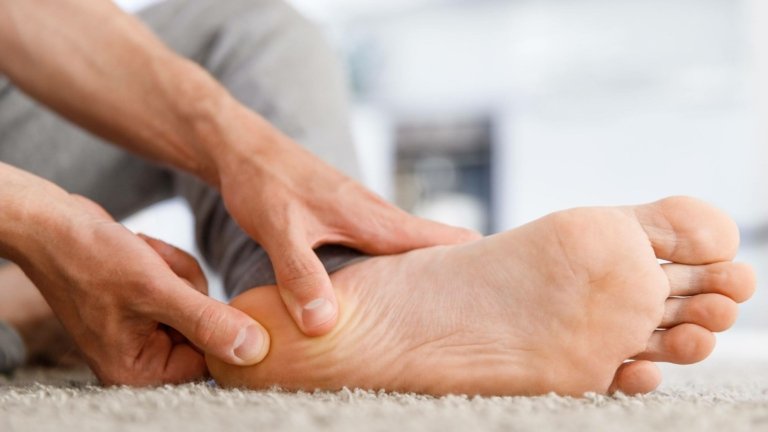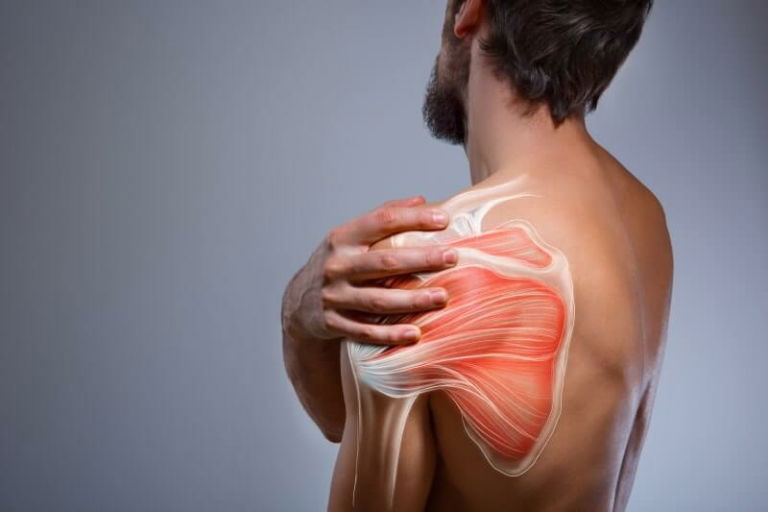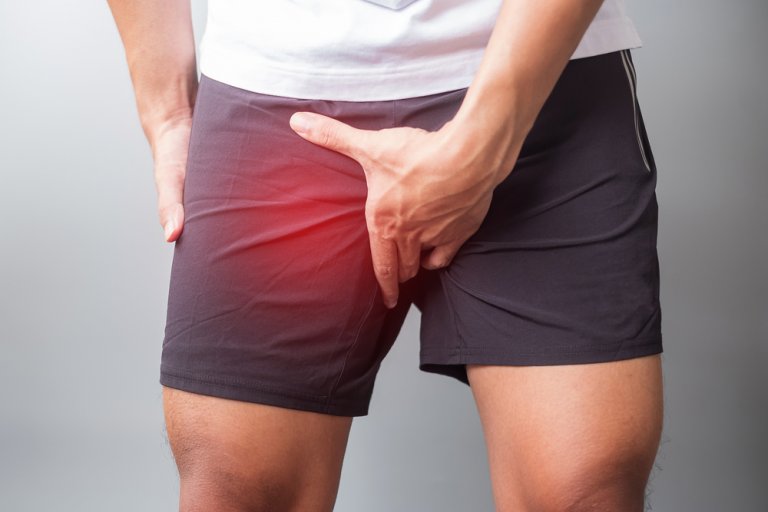-
Acromioclavicular (AC) syndesmolysis
-
ALPSA lesion
-
Bankart lesion
-
Bennett lesion
-
HAGL lesion
-
Hill-Sachs lesion
-
Calcific supraspinatus tendinitis
-
Calcifications in the infraspinatus tendon
-
Chronic avulsion fragments
-
McLaughlin lesion
-
Parsonage-Turner syndrome
-
Posterior subluxation of the shoulder
-
Posterior Bankart lesion
-
Supraspinatus tendon rupture
-
Os acromiale
-
Thoracic syndrome/span>
The shoulder joint is formed at the junction of three bones: the clavicle, the scapula, and the humerus. The end of the scapula is called the acromion, and the joint between this part of the scapula and the clavicle is called the acromioclavicular joint.
Acromioclavicular joint separation, or AC syndesmolysis, occurs when the clavicle separates from the scapula. This can cause instability of the clavicle and pain on palpation. It is usually caused by a fall directly onto the shoulder or a direct blow during a contact sport.
AC syndesmolysis is successfully treated as part of the MEDICOFIT specialist physiotherapy for the shoulder.
Book a diagnostic therapy appointment for the shoulder >>
An ALPSA (Anterior Labral Periosteal Sleeve Avulsion) lesion is similar to a Bankart lesion but involves a greater displacement of the anterior labrum and periosteal sleeve. This injury leads to serious instability of the joint because the damaged labrum is displaced medially and does not return to its original position. This condition usually requires surgical reconstruction to restore stability, as well as appropriate rehabilitation.
ALPSA lesion is successfully rehabilitated as part of the MEDICOFIT specialist physiotherapy for the shoulder.
Book a diagnostic therapy appointment for the shoulder >>
This is an injury to the anterior part of the inferior glenoid labrum and associated ligament that occurs during anterior dislocation of the shoulder – anterior shoulder dislocation. It leads to joint instability and increases the risk of repeated dislocations. Surgical reconstruction is often necessary to restore stability.
Bankart lesion is successfully rehabilitated as part of the MEDICOFIT specialist physiotherapy for the shoulder.
Book a diagnostic therapy appointment for the shoulder >>
This is a lesser-known chronic condition where a calcified rim appears along the posterior part of the glenoid labrum, which can lead to limited shoulder mobility and pain, especially when throwing or in sports with overhead movements. Bennett lesion often occurs in throwing sports (baseball, volleyball) and is treated with physiotherapy or, in extreme cases, surgical removal of the calcification.
Bennett lesion is successfully treated as part of the MEDICOFIT specialist physiotherapy for the shoulder.
Book a diagnostic therapy appointment for the shoulder >>
HAGL (Humeral Avulsion of Glenohumeral Ligament) lesion means avulsion of the inferior glenohumeral ligament at its insertion on the humerus. It is a rare injury that occurs with acute anterior dislocation of the shoulder. A
HAGL lesion causes shoulder instability and often requires surgical reconstruction to restore joint function.
A HAGL lesion is successfully treated as part of the MEDICOFIT specialist physiotherapy for the shoulder.
Book a diagnostic therapy appointment for the shoulder >>
This is an compression injury to the posterolateral part of the humeral head that occurs during anterior shoulder dislocation, when the head of the humerus hits the anterior edge of the glenoid. It often has a significant affect on shoulder stability.
A Hill-Sachs lesion is successfully treated as part of the MEDICOFIT specialist physiotherapy for the shoulder.
Book a diagnostic therapy appointment for the shoulder >>
Calcific or calcifying tendinitis is caused by a build-up of calcium in muscle tendons. Calcium deposits can accumulate in one place or occur in multiple places. If the deposits become enlarged or irritated, they can cause severe pain. Calcific tendinitis most often affects the rotator cuff – specifically the supraspinatus muscle.
The pain is severe, often sharp, with a deep pain in the background. The pain usually worsens with shoulder movement and is felt deep in the joint and along the upper outer part of the arm. The pain is typically worse at night and often causes difficulty sleeping.
Should calcification is successfully treated as part of the MEDICOFIT specialist physiotherapy for the shoulder.
Book a diagnostic therapy appointment for the shoulder >>
Calcifications in the infraspinatus tendon refers to the presence of calcium deposits in the tendon of the infraspinatus muscle, which is one of the rotator cuff muscles of the shoulder joint.
Calcifications in the infraspinatus tendon can cause pain, limited mobility of the shoulder joint, and in some cases, inflammation of the surrounding tissues.
Calcifications are successfully treated as part of the MEDICOFIT specialist physiotherapy for the shoulder.
Book a diagnostic therapy appointment for the shoulder >>
Small bone fragments remaining from previous shoulder injuries can cause pain and limitations of mobility. They often require arthroscopic removal.
We provide successful rehabilitation as part of the MEDICOFIT specialist physiotherapy for the shoulder.
Book a diagnostic therapy appointment for the shoulder >>
Reverse Hill-Sachs defect, also known as a McLaughlin lesion, is defined as an impaction fracture of anteromedial aspect of the humeral head following posterior dislocation of the humerus. It is of surgical importance to identify this lesion and correct it to prevent osteonecrosis.
Successful post-operative care is provided as part of the MEDICOFIT specialist physiotherapy for the shoulder.
Book a diagnostic therapy appointment for the shoulder >>
This is a rare condition that affects the brachial plexus and causes acute shoulder pain, followed by muscle weakness and atrophy. It is often triggered by infection, trauma, or vaccination. Treatment is primarily symptomatic and includes physiotherapy rehabilitation.
Parsonage-Turner syndrome is successfully treated as part of the MEDICOFIT specialist physiotherapy for the shoulder.
Book a diagnostic therapy appointment for the shoulder >>
It is a partial dislocation of the glenohumeral joint in a posterior direction due to damage or weakness of the ligaments and muscles. It is often accompanied by a feeling of instability and pain.
Subluxation of the shoulder is successfully treated as part of the MEDICOFIT specialist physiotherapy for the shoulder.
Book a diagnostic therapy appointment for the shoulder >>
Similar to an anterior Bankart lesion, but it is an injury to the back (posterior) part of the labrum. This injury is rarer and usually occurs with a posterior dislocation of the shoulder. It leads to instability of the shoulder joint and often requires surgical reconstruction to restore stability.
Rehabilitation is successfully provided as part of the MEDICOFIT specialist physiotherapy for the shoulder.
Book a diagnostic therapy appointment for the shoulder >>
A supraspinatus tendon rupture is a tear in the tendon of the muscle located at the back of the shoulder. It is one of the most frequently injured tendons in the rotator cuff. It usually occurs together with other injuries to the rotator cuff muscles, which may be the result of trauma or repetitive microtrauma that occurs when there is high load on the shoulder joint.
The tear can be partial or complete. A partial tear causes an incomplete rupture of the muscle fibres, so it can be treated conservatively, whereas a complete rupture requires surgical suturing of the tendon, which must be followed by physiotherapy rehabilitation.
Tendon ruptures are successfully treated as part of the MEDICOFIT specialist physiotherapy for the shoulder.
Book a diagnostic therapy appointment for the shoulder >>
It is an anatomical variation where the acromion (the part of the shoulder blade above the shoulder joint) does not fuse completely during development in adolescence, causing instability of the acromioclavicular joint. This can lead to shoulder pain, limited mobility, and difficulty raising your arm above your head.
Os acromiale is successfully treated as part of the MEDICOFIT specialist physiotherapy for the shoulder.
Book a diagnostic therapy appointment for the shoulder >>
Thoracic syndrome, or thoracic outlet syndrome, is a group of diseases where pressure is exerted on the blood vessels or nerves in the area between the neck and shoulder. This space is known as the thoracic outlet. Compression of the blood vessels and nerves can cause shoulder and neck pain, as well as numbness in the hands.
Common causes of thoracic syndrome are injuries from a car accident, repetitive work- or sport-related microtrauma, or pregnancy.
Thoracic syndrome is successfully treated as part of MEDICOFIT specialist physiotherapy for the shoulder.
Book a diagnostic therapy appointment for the shoulder >>












